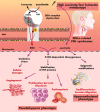Current approaches and recent developments in the management of head and neck paragangliomas
- PMID: 25033281
- PMCID: PMC4167435
- DOI: 10.1210/er.2014-1026
Current approaches and recent developments in the management of head and neck paragangliomas
Abstract
Head and neck paragangliomas (HNPGLs) are rare neuroendocrine tumors belonging to the family of pheochromocytoma/paraganglioma neoplasms. Despite advances in understanding the pathogenesis of these tumors, the growth potential and clinical outcome of individual cases remains largely unpredictable. Over several decades, surgical resection has long been the treatment of choice for HNPGLs. However, increasing experience in various forms of radiosurgery has been reported to result in curative-like outcomes, even for tumors localized in the most inaccessible anatomical areas. The emergence of such new therapies challenges the traditional paradigm for the management of HNPGLs. This review will assist and guide physicians who encounter patients with such tumors, either from a diagnostic or therapeutic standpoint. This review will also particularly emphasize current and emerging knowledge in genetics, imaging, and therapeutic options as well as the health-related quality of life for patients with HNPGLs.
Figures




References
-
- DeLellis RA, Lloyd RV, Heitz PU, Eng C. Pathology and Genetics of Tumours of Endocrine Organs. Vol 8 3rd ed Lyon, France: World Health Organization; 2004
-
- Mannelli M, Castellano M, Schiavi F, et al. Clinically guided genetic screening in a large cohort of italian patients with pheochromocytomas and/or functional or nonfunctional paragangliomas. J Clin Endocrinol Metab. 2009;94(5):1541–1547 - PubMed
-
- Sykes JM, Ossoff RH. Paragangliomas of the head and neck. Otolaryngol Clin North Am. 1986;19(4):755–767 - PubMed
-
- le Douarin N, Kalcheim C. The Neural Crest. 2nd ed Cambridge, UK: Cambridge University Press; 1999
-
- Unsicker K, Huber K, Schober A, Kalcheim C. Resolved and open issues in chromaffin cell development. Mech Dev. 2013;130(6–8):324–329 - PubMed
Publication types
MeSH terms
Grants and funding
LinkOut - more resources
Full Text Sources
Other Literature Sources
Medical

